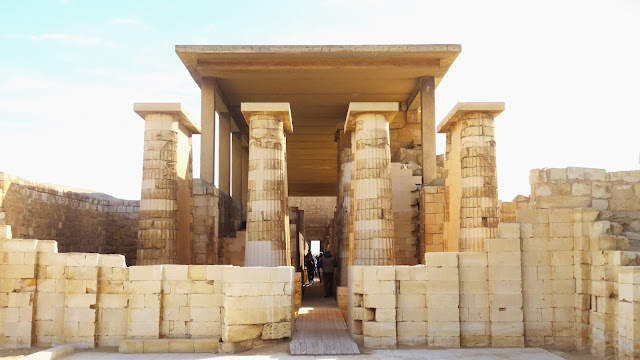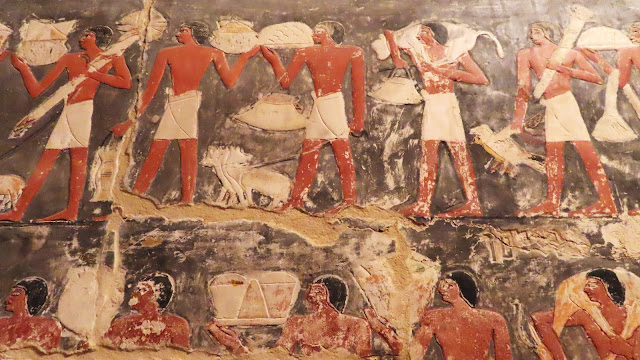February 11, 2023
Adventures into the Pyramids and Tombs of the Old Kingdom
Today, we ventured off the primary tourist track to visit less well-known sights. The adventure was, for me, even more exciting than our first day. The Pyramids of Giza yesterday were so familiar to us that it was like meeting old friends. Today, we really got INTO the pyramids, in the literal sense!
Irene, our wonderful guide, and Said, our driver today, picked us up after breakfast and drove us far out of Cairo toward "upper Egypt." (This brought up memories of my early teaching days when the seventh grade curriculum still included the ancient world. My students sometimes had trouble grasping the idea that "lower Egypt" is at the top of the map, because the Nile flows from the south to the north into the Mediterranean Sea.)
Our first stop was the complex of buildings at Saqqara (Sakkara), which includes the "Step Pyramid."
One of the helpful signs around the complex provided more information about the pyramid:
"Built by Djoser, the first king of the Third Dynasty (around 2700 B.C.)
The Step Pyramid is the first pyramid and the first large stone building in history. It was not built all at once, but in stages. A square mastaba of about 63 meters in side-length and about 8.5 meters in height was first built, then there was an addition of three meters on each side and another addition of nine meters on the east side, to link the building to eleven shafts belonging to the family of Djoser. The mastaba was later enlarged through the addition of four mastabas built atop one another, before reaching its current form of six mastabas measuring 60 meters in height. The base of the pyramid is about 121 m x 109 m.
The Burial Chamber lies at the bottom of a shaft in the center of the pyramid at a depth of 28 m. There are several levels underneath the pyramid at depths of up to 40 m, where over 30,000 jars made of solid stone were found, the most important of which are made of granite, alabaster, and schist. Inscriptions of King Djoser at the celebration of the Heb-Sed Festival can also be found at the bottom of the pyramid, as well as unique blue and green ceramic tiles.
The work was led by the brilliant architect Imhotep, who held titles such as Advisory to the King of Lower Egypt, "the First After the King" of Upper Egypt, Administrator of the Great Palace, Hereditary Prince and Grand Visionary of Heliopolis (a title related to sun worship and astronomy). Imhotep was deified in Ancient Egypt and was a patron of the scribes. The Greeks identified him with Asclepius, the god of medicine.
The Step Pyramid is considered to be a giant stairway, which King Djoser would climb after being resurrected to join the sun god Ra in the sky."
 |
| We had "met" King Djoser in the Egyptian Museum the day before. |
We entered the large square in front of the pyramid through a section of the great wall that used to surround this complex of pyramids, temples, mummification centers, and tombs of the nobles. The sandy square was bustling with tourists from all over the world. I heard guides leading tours in French, German, Italian, Japanese, and other languages. Around the perimeter of the huge square were the remnants of other temples and tombs.
 |
The upper wall of the Southern Tomb is decorated with a frieze of cobra heads, while the lower level includes a ramp leading down to a burial chamber which includes a huge sarcophagus.
The inside corridors are covered with reliefs showing the Pharaoh taking part in the Heb-Sed Festival, which was a royal jubilee with the aim of rejuvenating the king and renewing his right to rule. |
Visitors are allowed to enter the pyramid, so Rob and I descended the stairway into the south entrance to the tomb and walked down a passageway that was so low that Rob had to walk stooped over the entire way. A sign informed us that the columns in the corridor were added about 1,000 years after the original construction when the kings of the 26th Dynasty took care of the monuments of their illustrious ancestors. At the end of the passage, we peered down the deep shaft where the limestone blocks marked the burial spot of one of the pharaohs.
The Step Pyramid wasn't the only highlight of Saqqara! Irene led us though the other areas of the complex where we saw other less-well preserved pyramids, lots of excavation still ongoing here, and the best of all, the burial tombs of some of the nobles of Saqqara.
 |
| Buildings of the Saqqara Complex in front of the ruins of a pyramid |
We entered the Tomb of Mehu and were immediately immersed in the ancient world, beautifully preserved. The walls were covered with hieroglyphics, many still retaining their bright colors. Images of people from all levels of society, from soldiers to farmers to fishermen were displayed on the walls. While we had seen similar things on the artifacts in the museum, this was art "in situ," in its original location. I found myself incredibly grateful that the ancient Egyptians cared so much about carrying all their life experiences into the afterlife. They left us with such a treasure!
 |
This is the tomb of Mehu and his family. He was a high-ranking nobleman with more than sixty titles, including governor of the region, the palace secrets keeper, the head of the houses, the judge of the judiciary, and the supervisor of the treasury house!
He was also married to two women of the royal house |
 |
Mehu's tomb is decorated with illustrations of scenes from daily life, including
harvesting, herding, fishing, boating, and cooking. |
We explored three other interesting tombs: the Tomb of Irukapta (the Butchers), the Tomb of Neferherenptah (the Birds), and the tomb of Niankhkhnum and Khnumhotep, who were the hairdressers to the Pharaoh and oversaw the manicurists. (Who knew that pharaohs had manicures?!) All three of these tombs were highly decorated, and thanks to the Rosetta Stone, archaeologists can decipher the thousands of hieroglyphics that have told us so much about the ancient Egyptian people and history.
 |
The tomb of Irukaptah includes nine of his family members.
He was the head of the butchers at the Royal Palace. |
 |
| The long rectangular hall contains rows of statues |
 |
| Above the statues are scenes of animal slaughter |
 |
| Statues of Irukaptah and his family |
The Tomb of Neferherenptah (the Tomb of the Birds) was notable for its scenes of everyday life. The most famous are the scenes of bird hunting, fig picking, and wine making.
 |
| Scenes of royal barges and food preparation |
The last Saqqara tomb we visited was the Tomb of Niankhkhnum and Khnumhotep, which is also known as "Tomb of Two Brothers." Th ey were two priests in the Sun Temple of Niuser, and they were also the Pharaoh's hairdresser. Despite referring to them as brothers, they were more likely to have been close friends who decided to build a common tomb for themselves and their families. Within the tomb, there are two paintings of the men embracing, a scene that is found nowhere else in Saqqara.
We said farewell to Saqqara and drove another half-hour to two unusual pyramids we had seen in the distance from a high point in the complex. These were the "Bent Pyramid" and the "Red Pyramid" of Dashour. All of these sites are near the Nile, and we enjoyed the glimpses of rural life and agriculture in this area.
 |
| The "Bent Pyramid" and the "Red Pyramid" far in the distance. |
 |
| We saw many horse and donkey carts during this trip - even in Cairo! |
It is clear how the Bent Pyramid got its name. It was an early pyramid, and somehow the architect misjudged the angle needed to achieve the classic shape, so part-way through its construction, the angle was changed, leaving it with a unique shape. It is also important for retaining the most complete smooth limestone casing of all the pyramids. I walked up the modern wooden staircase to the entrance of the hall leading to the burial chamber for some fantastic views of the barren landscape and the Saqqara complex far in the distance, but I did not enter the pyramid.
 |
| The Bent Pyramid |
 |
| Irene, our lovely and knowledgeable guide, with Joan |
 |
| Waving from the entrance into the Bent Pyramid |
I DID enter the Red Pyramid, and that was the biggest - or at least the most vigorous - moment of the day. The Red Pyramid gets its reddish color from iron oxide in the rocks used in its construction. I climbed the long wooden staircase leading to the entrance high on the side of the pyramid, then inched my way slowly down the steep ramp in a VERY low-roofed and dark tunnel to the chamber at the bottom of the inside of the pyramid. It was frightening. The only way to descend was to creep backwards in the dark (with a few lights placed here and there), feeling with my foot for the iron bars that crossed the rock and acted as brakes. For a long time, I couldn't see the end of the ramp when I looked over my shoulder, and I was just starting to feel that I'd never get there, when at last, I felt flat rock beneath my foot. Then I stooped through one more low tunnel and finally stood up in the great burial chamber. There was no decoration, just a big stone room, so the thrill of this pyramid was just the GETTING here! The ascent went much more quickly, as I didn't have to be so cautious about feeling my way, but I was relieved to finally reach the top. I was sure that this would be the most vigorous experience of this entire trip!
 |
| The Red Pyramid |
We ended our tour with a late lunch at a lively restaurant offering traditional Egyptian food to locals, as well as tourists. Two women were outside baking pita bread in traditional ovens, and it came to our table still piping hot.
 |
| Our lunch restaurant |
 |
| A traditional Egyptian meal |
 |
| Making pita bread in traditional ovens. |
Rob and I were both thrilled with the sights of the day, but also very happy to return to the hotel soon enough to collapse for a much-needed nap. We didn't do much else the rest of the day until a light dinner in the hotel. Whew!
















































No comments:
Post a Comment